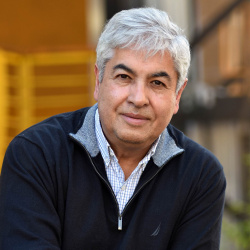Deputy Director of the Centro Interdisciplinario de Neurociencia de Valparaíso.
Full professor, Institute of Neuroscience, Faculty of Sciences, Universidad de Valparaíso. Biochemist, Universidad de Concepción, Chile Ph.D. en Ciencias, mención Neurociencias, Albert Einstein College of Medicine of Yeshiva University, Nueva York, E.E.U.U.
Contact information:
E-mail: juancarlos.saez@uv.cl
Pasaje Harrington 287, Playa Ancha. Valparaíso
Phone: (56)-(32)-2508040
Regulation and function of connexin and pannexin based membrane channels. In collaboration with students (undergraduate and graduate), Chilean and international researchers, we study the regulation and functional roles of plasma membrane channels formed by connexins (Cxs) or pannexins (Panxs), which are proteins expressed by most cell types in vertebrates. They constitute channels termed gap junction channels (GJCs) and hemichannels (HCs) or connexons. GJCs communicate the cytoplasm of contacting cells and HCs communicate the intra and extra cellular compartments. We also study the interactions of Cx and Panx based channels with purinergic receptors (P2). All these channels are crucial in the coordination of numerous cellular responses in diverse tissues. Our studies focus mainly in normal and aberrant functioning of the nervous and immune systems. We use primary cultures, cell lines and animal models of inflammatory diseases or diseases that evolve with an inflammatory response. We analyze the effects of neurotransmitters, hormones and pro-inflammatory conditions on the extent of intercellular communication and cell death mediated by the channels of interest. Biochemical, biophysical, cellular and molecular biological techniques are used to study the expression, post-transcriptional modifications and intercellular trafficking of Cxs and Panxs. In collaboration with industries (R+D), we are currently developing chemical compounds that affect these channels to control the deleterious consequences of pro-inflammatory conditions. Since regeneration is the last step of inflammatory responses and shares numerous features with tissue ontogeny, we also perform research on the regulation and function of the channels of interest in cell growth and differentiation. The final goal of the latter is to gain knowledge on the role of GJCs and HCs in tumorogenesis.
- Cisterna CB., Vargas A.A., Puebla C., Lagos C.F., Escamilla R., Matus M-F., Vilos C., Cea L.A., Barnafi E., Gaete H., Escobar D.F., Cardozo C., Sáez J.C. Active acetylcholine receptors prevent the atrophy of skeletal muscles and favor reinnervation. Nature Comm. 11: 1073, (2020).
- Sáez PJ, Vargas,P, Shoji KF, Harcha PA, Lennon-Duménil A-M, Sáez JC. ATP promotes the fast migration of dendritic cells through the activity of pannexin 1 channels and P2X7 receptors. Science Signaling 2017 Nov 21;10(506). pii: eaah7107. doi: 10.1126/scisignal.aah7107.
- Cea LC, Cisterna BA, Puebla C, Frank M, Figueroa XF, Cardozo C, Willecke K, Latorre R, Sáez JC. De novo expression of connexin hemichannels in denervated fast skeletal muscles leads to atrophy. Proc. Natl. Acad. Sci. USA 110:16229-16234 (2013).
- Orellana JA, Froger N, Ezan P, Jiang JX, Bennett MV, Naus CC, Giaume C, Sáez JC. ATP and glutamate hemichannels mediate neuronal death through released via astroglial connexin 43 activation of pannexin 1 hemichannels. J Neurochem. 118:826-40 (2011).
- Retamal MA, Cortés CJ, Reuss L, Bennett MVL, Sáez JC. S-nitrosylation and permeation through connexin 43 hemichannels in astrocytes: induction by oxidant stress and reversal by reducing agents. Proc. Natl. Acad. Sci. USA. 103: 4475-4480 (2006).



